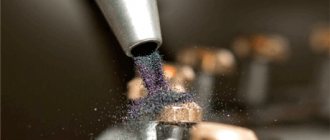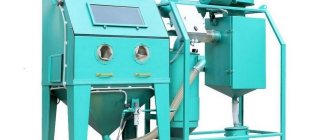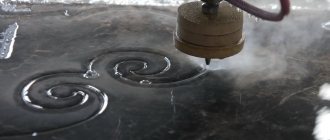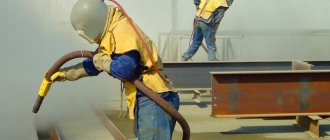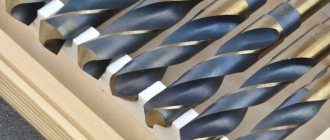Sandblasting of metal is a technology that allows it to be cleaned with high efficiency using an abrasive. It can also be used for products and structures made of any other materials. This treatment helps to clean surfaces not only from various contaminants, but also from traces of corrosion, oil stains, and molding sand residues.
Sandblasting is the best way to clean a car body
The cost of sandblasting is only decreasing every year, which cannot but please consumers. This trend is explained by the fact that this technology and sandblasting equipment are constantly being improved and involve the use of new, more efficient consumables.
More articles on this topic: > Do-it-yourself sandblasting: drawings, videos, manufacturing instructions > Homemade sandblasting gun > Sandblasting from Karcher: nozzle for a high-pressure washer
The essence and purpose of the technology
When performing sandblasting, products and materials are cleaned from dirt, dust, grease, molding sands and coatings using abrasive substances. The principle of the technique is based on the interaction of an air-abrasive mixture, supplied under pressure, with the surface of the base, which leads to detachment of the plaque located on top.
To “accelerate” the abrasive, special equipment is used - a sandblasting machine with a compressor, which creates the required pressure in the system (usually 6-9 atmospheres). Afterwards, sand or other abrasive is captured by the air flow and thrown onto the working surface. The speed of particle movement is very high: on average, it is 720 m/s.
Sandblasting allows you to thoroughly clean the metal and prepare it for painting or other types of finishing work. Moreover, the top layer of the product becomes slightly rough, so adhesion to paintwork increases significantly and service life increases.
The coating will be most durable after deep sandblasting, which removes even hidden pockets of corrosion and other base defects. In industry, sandblasting is also used to effectively remove dirt and grease stains, and to increase the reliability of welding work.
Occupational Safety and Health
The sandblasting installation is high-risk equipment.
- Persons who have reached the age of 18, have passed a medical examination and are fit for health reasons to perform this work are allowed to work on this type of equipment.
- Before work, you need to put on a work suit made of cotton fabric that protects against industrial pollution, protective leather work boots, and you need to put on safety glasses to protect your eyesight.
3. Therefore, before performing sandblasting work, the worker must be familiar with safe work practices.
- keep your workplace clean, do not block aisles and passages with products.
- Do not eat in the workplace; wash your hands with soap and water before eating.
Types of sandblasting
Depending on the depth and intensity of processing, the following degrees of material purification are distinguished:
- Easy. Only large traces of rust are removed, as well as scale and flaking paint. Its effectiveness is similar to manual processing with a wire brush.
- Partial (selective). No more than 5-10% of the surface is processed.
- Average. Upon visual contact, the product looks clean, but hidden traces of corrosion may remain (they account for less than 10% of the area).
- Deep. All dirt and rust are completely removed from the surface. The consumption of abrasive substances during such processing is significant.
There is another classification of levels of metal purification:
- removing - removes dirt and old paint from the base, but some of the rough layers can remain provided that they do not interfere with the high-quality application of subsequent coatings;
- fine – no contamination, moderate roughness;
- commercial - any dirt, grease, scale, no traces of pitting corrosion, there may be small chips and stripes.
Types of Sandblasting Equipment
There are two types of devices for abrasive cleaning of materials on the market. Mobile units are compact in size, so they can be easily moved to any location by one person. Usually, strong protective equipment is required for work, because the air in the area of the device becomes very dusty and becomes dangerous to human health.
Stationary automatic cameras are enclosed spaces with the necessary equipment located inside. Such devices are safe for the operator, because he only puts his hands into them through special thick gloves. Thanks to the presence of a special system, the abrasive in most devices can be reused. The dimensions of the processed products are limited by the dimensions of the chambers: most often they only contain small parts.
Sandblasting equipment also differs in operating principle. Here are the main categories of sandblasters:
- Pressure. A special feature of the work is the method of supplying the abrasive material - it goes through one hose with air, and not separately. The performance of such devices is high, but strongly depends on the power of the compressor. It is best to use pressure sandblasters for cleaning large areas.
- Injection. Air and abrasive flow through different sleeves, so the nozzle is divided into two channels - air and abrasive. The productivity of such installations is much lower, so they are usually used for domestic purposes, for applying designs, for decorative processing or to provide roughness to the surface.
- Vacuum. They are a subtype of pressure devices, but have some design features. After being thrown onto the surface being treated, the abrasive is sucked inside by vacuum. Such units are used an order of magnitude less frequently than others due to their low productivity.
How to operate the device correctly
The operation of the device is carried out as follows. Before starting work, you should read the operating instructions for the equipment. Before starting work, you need to check the proper operation of the lifting and transport equipment at idle speed. Turn on the work lights. Turn on the exhaust ventilation and check how well it works. After loading the product for cleaning into the working area of the chamber, you need to close the chamber door tightly. Then turn on the exhaust ventilation, approach from the side of the observation window, put your hands into the special holes, inside of which there are protective gloves. With your hands in protective gloves, take the gun, pull the trigger and direct a stream of air with abrasive to sandblast. After complete cleaning, place the gun in place inside the chamber, turn off the compressed air supply, then open the chamber door and unload the cleaned product, and store it in a designated place for subsequent transportation to the next operation.
Types of abrasive materials
The very first abrasive for surface treatment was sand: the devices got their name from it. Nowadays, metal is cleaned using sand and other, more modern and effective materials. They differ in the following physical characteristics:
- hardness – determines the intensity of processing and its speed;
- particle size – coarse-grained materials have a higher impact force;
- uniformity – uniform surface treatment is ensured only by particles of approximately the same size;
- shape - round elements remove dirt through direct contact with the surface, elongated ones act by friction, grain-shaped ones give a polishing effect.
Abrasive materials are also classified by origin:
- Natural. The group includes different types of sand - river, quartz, desert, sea. Now their use is limited, since there are many more effective analogues.
- Vegetable. These are different seeds, husks, and other products of plant processing. They are very gentle and are most often used to clean delicate surfaces.
- Industrial. They can be based on metal, products of its processing, or non-metallic. The most famous abrasive in this group is steel shot, which can be used repeatedly. The most commonly used non-metallic abrasives are glass grain and crushed plastic, and waste abrasives are slag and corundum.
Pros and cons of processing
Sandblasting has a number of advantages:
- speed of cleaning surfaces, especially in comparison with manual action;
- excellent quality of work - the air-abrasive mixture guarantees the removal of absolutely all types of dirt and old coatings;
- the ability to independently regulate the type of cleaning - this property is achieved by changing the operating pressure of the installation;
- no harm to the metal - the thickness of the product does not change, as well as other parameters;
- versatility - sandblasting is suitable for almost all metal products, as well as glass, wood, concrete and a number of other materials.
There are also disadvantages to this type of processing. If the installation is industrial, the operator will need to undergo training. For small household devices, this point can be skipped, but familiarization with safety measures is still required.
The price of good devices is quite high, especially when it comes to stationary cameras. The use of sand can be hazardous to health, because the smallest particles of sand dust can settle in the lungs and cause serious illness. Instead of sand, it is better to use more modern abrasives, but they are much more expensive.
Main processing rules
You can get a truly high-quality processing result only by selecting good equipment, consumables and components. The abrasive material must be ideally suited for the specific type of work, otherwise the surface will not be cleaned sufficiently or will be scratched.
The higher the performance of the sandblasting compressor, the faster the cleaning will occur, and the greater the efficiency. It is necessary to select installations with hoses of significant diameter to reduce pressure losses. Couplings and connectors must exactly match the diameters of the hoses. You should also pay attention to the quality of the nozzle - the most durable ones are made from boron carbide, however, they cost much higher than others.
Features of application
It is not recommended to reuse abrasive materials, even if their consumption is very high. The fact is that wet materials that have already been used in work can cause equipment malfunctions.
Another important option of household devices is that you can urgently stop their operation if necessary, the operator carrying out the work will not be harmed.
But when using, we must not forget about simple safety rules: work exclusively in overalls and shoes, use eye and respiratory protection.
Sandblasting of the body and body elements
Body treatment is the most popular type of work with a sandblasting machine. With its help, you can clean the surface of old dirt, remove traces of scale, paint, and rust. Sandblasting also helps to assess the degree of corrosion damage to the metal and choose the optimal method for its restoration.
Sandblasting of vehicle components and assemblies
Cleaning the surface of important components, connections and machine parts using sandblasting is considered the most effective way to protect them from damage. In addition to removing rust, stains and old coatings, the treatment helps improve the adhesion of metal to primer, paint, and varnish.
Sandblasting discs
Sandblasting of wheel rims is a popular service in auto repair shops. It helps to remove all contaminants from the base, including old and high-density ones, removes traces of rust and paint, making the base suitable for restoration. Using sandblasting, you can rid disks of primary corrosion (scale), difficult to remove spot rust, and increase strength and visual appeal. After sandblasting and powder coating, the wheels will look like new.
Sandblasting of frames and trailers
Before restoration and painting of frames and trailers, abrasive treatment is required, which in the future will protect the metal from the destructive effects of corrosion. Sandblasting is especially recommended if you have the following problems:
- pollution caused by high temperatures;
- traces of pitting or other rust;
- mold, fungus;
- greasy deposits, petrochemical residues;
- the anti-corrosion coating has begun to deteriorate.
Sandblasting motorcycle parts
Using sandblasting, you can easily clean various motorcycle parts from any contaminants. Most often, when repairing equipment, sandblasting is carried out on the following components and elements:
- frame;
- wings;
- pendulum;
- side covers;
- tank;
- muffler;
- calipers;
- disks;
- steering wheel;
- stroller, stroller frame;
- traverse.
Cleaning metal from corrosion
At home, metal is most often removed from rust using chemicals - so-called converters. But the efficiency of their work remains at a low level if the corrosion areas are multiple or deep. If there are hidden elements, they can be easily missed. Usually only the top layer of rust is removed, and the corrosion process continues to develop.
Sandblasting removes even deep damage to metal by rust, and is suitable for any components, parts, surfaces. It is advisable to always subject products to this treatment before applying a new protective or decorative coating.
Removing paintwork
To clean varnish and paint from small surfaces, you can use a wire brush or sandpaper. But manual cleaning of old paintwork on large surfaces will be difficult and time-consuming. It is better to use sandblasting technology, which has several advantages:
- high speed - it is possible to remove paint on 100 square meters of surface or more in a day;
- versatility - you can get rid of any type of paint coating;
- grinding and matting - in addition to removing old paint, varnish, making the metal clean and shiny, microscopic grooves are created on the surface, which enhances adhesion to a new layer of paint;
- ideal result - thanks to sandblasting, you can remove paint residues even in hard-to-reach places.
conclusions
If you are looking for a suitable way to clean metal or prepare it before painting, sandblasting will be the best option in most cases. Due to its high productivity and cost-effectiveness, metal sandblasting has been the most popular method of cleaning and preparing metal before applying protective coatings for many years.
With the development of technology, hand tools are being improved and new types of equipment for cleaning metal surfaces are appearing; perhaps some of them will occupy their niche in the future and will be able to compete with sandblasting. However, sandblasting technology itself does not stand still: new technological solutions are emerging and old ones are being improved, making it possible to increase labor productivity and increase the efficiency and safety level of equipment. A wide selection of modern abrasives makes it possible to select the optimal materials for a wide variety of tasks.
Do not forget that the efficiency and economic result of your work will directly depend on the correct choice of equipment, its layout, selection of abrasives appropriate for the tasks and professional training of personnel.
Using a sandblasting machine at home
Specialized stores offer various models of sandblasting machines, many of which are well suited for home use. Particularly popular are devices from the Karcher brand, which are suitable for processing any area. Some craftsmen call sandblasting “facade guns,” because they are often used during building restoration work.
At home, using sandblasting, you can clean both flat metal bases and three-dimensional structures made of different materials. Mobile devices that are compact in size and easily move around the area are best suited for everyday use. One person can operate such a device; no assistants are required.
Most modern machines use not only quartz sand as an abrasive, but also other materials. It is important that the size of the fraction corresponds to the diameter of the nozzle, because the particles must pass freely through the opening of the nozzle.
Cleaning up after a fire
Treatment of metal that has been damaged by a fire involves removing carbon deposits from the surface of the product. This type of contamination is formed due to high temperature and is difficult to remove manually. But sandblasting quickly cleans dirt and grease by exposing the metal to a stream of air-abrasive mixture.
Restoration of buildings
Sandblasting work is in great demand when restoring old and damaged structures and buildings. Sandblasting allows you to extend the life of houses, is used in the restoration of historical objects, and is used at certain stages of work on the construction of new buildings.
Façade cleaning and graffiti removal
Removing the walls of buildings from inscriptions and dirt can also be done using sandblasting. Painting over drawings most often does not give the desired result; moreover, to maintain its attractiveness, the facade will have to be painted completely. But with the help of sandblasting you can quickly and without extra costs remove all the inscriptions and dirt from the house, restoring its “appearance”.
Brick cleaning
You can also maintain the beautiful appearance of masonry through sandblasting. It is carried out regularly to get rid of plaque, dirt, and darkening. Sandblasting allows you to remove dirt even from seams, grooves and other hard-to-reach areas.
Granite restoration
Granite provides the building with strength and aesthetics, but over time it ages, darkens and requires restoration work. Sandblasting is an ideal option for restoring the natural beauty of granite. Small abrasive particles will restore shine to the masonry, remove dirt and abrasions, and as a result, buildings and structures will look like new.
Drawing on glass and mirrors
The use of special attachments allows the use of sandblasting machines for painting on glass, mirror surfaces, as well as wooden and metal frames of similar products. Using sandblasting, you can remove old paintwork, add shine to the surface, and then create original decor on it.
Sandblasting of products is useful in industry and everyday life. Multifunctionality, versatility, and ease of working with sandblasting equipment make it in demand in a variety of activities, especially since operating the devices does not require special skills and knowledge.
What to look for when choosing a sandblasting machine
At the stage of selecting the necessary equipment, experts recommend paying attention to the following nuances:
- The dimensions and weight of the compressor are the key to comfortable movement around the work site.
- The manufacturer must produce the tank in accordance with the safety requirements for the manufacture of pressure vessels.
- A large number of hoses and fittings leads to a loss of performance of the device. For best performance, we recommend using sleeves with a diameter of at least one inch.
- The device must be adapted for all types of abrasive materials: from sand to cast iron shot.
- To ensure additional safety, you can purchase a unit with an additional safety valve that operates automatically.
- The volume of the container for storing consumables should be 60% of the capacity of the pressure vessel. A separate worker is required to service it.
- Pay attention to the volume of the pressure tank. When fully loaded, the abrasive should last at least 30 minutes. Material consumption is calculated based on the nozzle diameter and pressure force. The jet power does not affect the capacity.
- It is imperative to have a dosing mechanism that optimizes sand consumption.
- Shut-off valves are installed on the inlet and outlet lines.
- A large inspection hatch provides comfortable access to the loading area.
- When working with reusable materials, a special filter in the form of a sieve is installed on the loading funnel, which filters out grains of the wrong size.
- For long periods of work, use a compressor with a double tank.
Sandblasting machines entered the domestic market relatively recently, but users have already appreciated the convenience and performance of these devices when carrying out preparatory work on metal surfaces. If you have experience successfully using sandblasting technologies at home, share it in the comments section.
